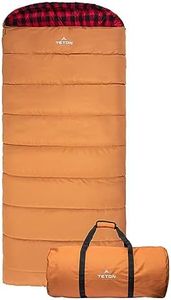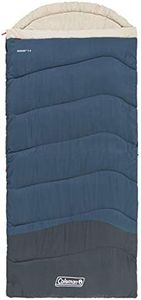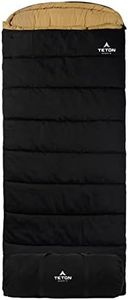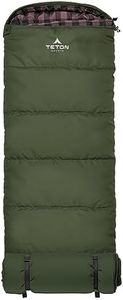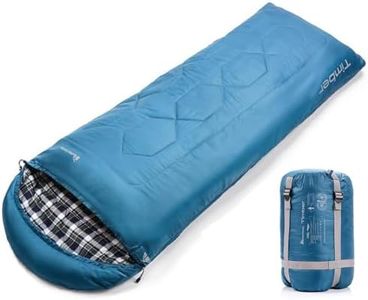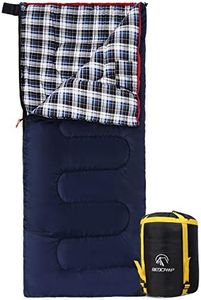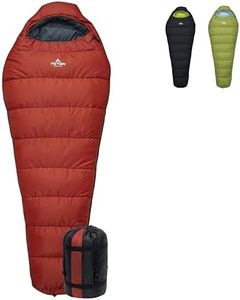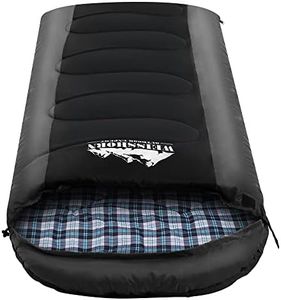We Use CookiesWe use cookies to enhance the security, performance,
functionality and for analytical and promotional activities. By continuing to browse this site you
are agreeing to our privacy policy
10 Best Canvas Sleeping Bags
From leading brands and best sellers available on the web.Buying Guide for the Best Canvas Sleeping Bags
Choosing the right canvas sleeping bag can make a big difference in how comfortable and restful your outdoor sleep will be. Canvas sleeping bags are known for their durability and ability to provide warmth and protection in different conditions. When picking a sleeping bag, it's important to consider when and where you’ll be using it, how portable you need it to be, and how much space and warmth you need. Understanding the key features will help you match a sleeping bag to your personal outdoor needs.Material and Outer FabricThe material or outer fabric of a sleeping bag refers to what covers the outside of the bag. Canvas is a strong, thick, and durable fabric, often made from cotton or a blend, used for the exterior. This material is important because it provides tough protection against rough ground, weather, and general wear and tear, making it suitable for camping in different terrains. If you prefer maximum durability and aren’t too concerned about weight, then canvas is a great pick. Thicker, 100% cotton canvas is best for longevity and heavy-duty use, while lighter canvas blends could work if you need less weight. Consider where you’ll camp: for rugged areas, choose a heavy-duty canvas, but for lighter hiking trips, a canvas blend may be easier to carry.
Insulation TypeInsulation is what keeps you warm inside your sleeping bag. Common choices for canvas sleeping bags are synthetic fibers or natural down feathers. Synthetic insulation dries faster and performs better in wet conditions, while down insulation is lighter and warmer for its weight but can lose warmth when wet. If you camp in damp or unpredictable weather, synthetic is often the better option because it’s easier to care for. If you mostly camp in dry, cold areas, down may be warmer and lighter to pack. Think about the weather you’ll face most often to guide your choice.
Temperature RatingThis is a number, usually in degrees (Celsius or Fahrenheit), that tells you the lowest temperature the bag is designed to keep an average person warm. This is one of the most important specs to pay attention to. Bags rated for lower temperatures are bulkier and warmer, while those rated for higher temperatures are lighter and less warm. If you camp in cold climates or during fall and winter, select a bag with a lower temperature rating. For summer or mild weather camping, a higher temperature rating will keep you from overheating. Match the lowest expected nighttime temperature of your camping area to the rating.
Bag Shape and SizeSleeping bags come in shapes like rectangular, mummy, and semi-rectangular. Canvas bags are often rectangular, giving you more room to move, but there are mummy-shaped options for more warmth and less bulk. The size is about both the length and width—too small and you’ll feel squeezed, too large and you may lose heat. If you like to sprawl out as you sleep, or want to zip two bags together, a rectangular, wider bag is ideal. For maximum warmth in cold, choose a shape that holds heat close to your body. Check the dimensions to make sure the bag will fit your height and sleep style.
Weight and PackabilityThis tells you how heavy and bulky the sleeping bag is when packed up. Canvas sleeping bags are generally heavier and bulkier than others because of their tough fabric, so they’re best for car camping or short walks to a campsite. If you need to travel light or backpack, check for canvas blends or slim designs that pack down smaller. The more stationary your camping (like base camps or car camping), the less you need to worry about weight.
Lining MaterialThe lining is what touches your skin inside the bag, and can affect comfort and warmth. Common lining materials include flannel, cotton, or polyester. Flannel and cotton linings feel soft and cozy, ideal for comfort during chilly nights, while polyester dries quickly and is easier to clean. If comfort is your priority and you camp in cooler weather, look for flannel or cotton. For easier maintenance or damp conditions, polyester is a good fit.

